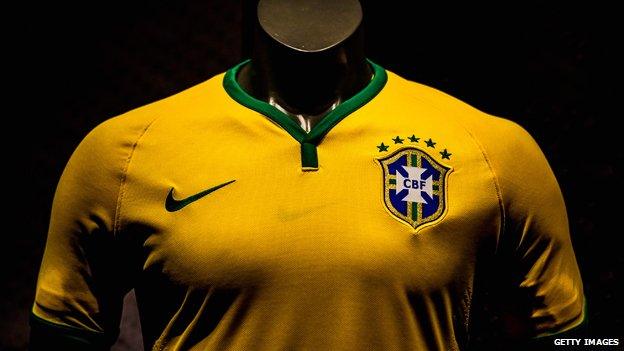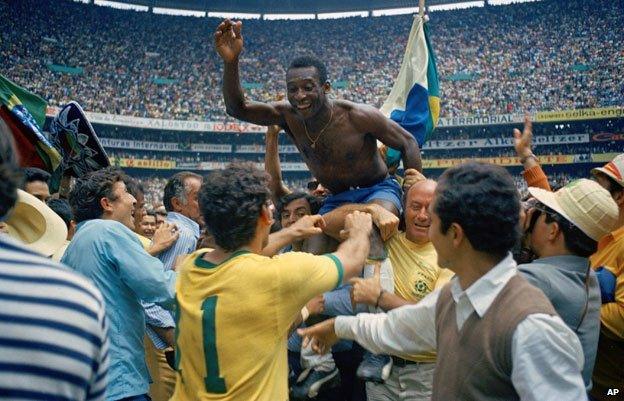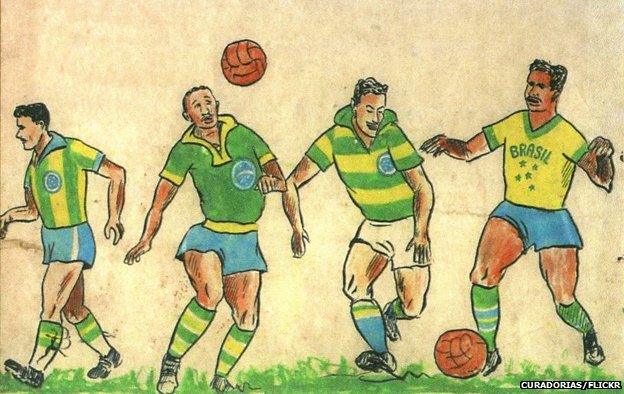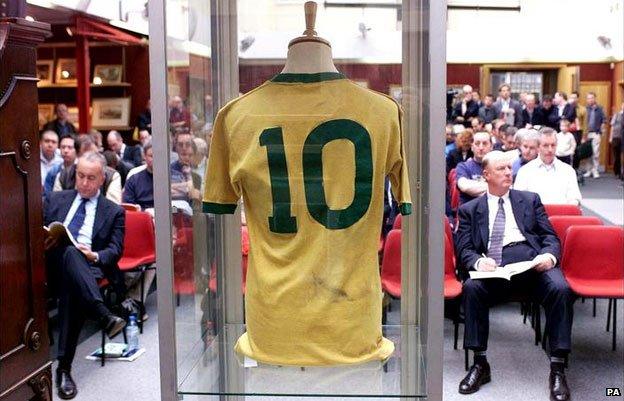The story of Brazil's 'sacred' yellow and green jersey
- Published

When Brazil play their first knockout game of this World Cup on Saturday, a football-crazy nation will be rooting for them. But many lovers of the game elsewhere will also be hoping to see the daring, imaginative play they have come to associate with the distinctive yellow shirt.
It is an international symbol of joy. A football shirt that conjures up images of the game's greatest players, playing the beautiful game in the most beautiful of ways.
It has become synonymous with the glamour, magic and fun of Brazilian football on the backs of players such as Pele, Jairzinho, Zico and Socrates, who took football to new heights during the second half of the 20th Century.
"For Brazilians, that yellow jersey is sacred," says Carlos Alberto, captain of the great 1970 World Cup-winning side.
"When we wear it, of course we feel pride but it also brings responsibility, a responsibility to inspire and to excite."
Alongside the pinstripes of baseball's New York Yankees, it has become the most iconic kit in sport. Yellow shirt with green trim. Blue shorts with white stripe. White socks. Distinct and dynamic colours that cannot be confused or mistaken for any other team.
Walk down the street in Sao Paulo, San Diego or Slough, Fortaleza, Frankfurt or Fort William and before long, you are likely to encounter someone wearing a Brazil football shirt, most probably carrying the number 10 on the back.

But it's unlikely that many know how Brazil came to wear yellow, or that there was ever a time when they didn't.
As with so much in Brazilian football, the story dates back to a stunning 2-1 defeat by Uruguay on home soil in the final match of the 1950 World Cup.
This proved to be a watershed moment, a reference point for the country's footballing aspirations. The recriminations were fierce and far-reaching, and the team colours were not immune.

Brazil humiliated
As Uruguay striker Alcides Ghiggia peeled away to celebrate, he noticed the huge new Maracana stadium had fallen silent.
"Three people have silenced the Maracana - Frank Sinatra, the Pope and me," he recalls.

The white shirts, with blue collars, white shorts and white socks that they had played in until that moment were deemed unpatriotic, not reflective of the Brazilian flag in which the green represents the vast swathes of forest, the golden yellow the country's raw wealth and the blue globe and white stars, the Rio sky at night. It was time to start again. In 1953, a competition was launched by a newspaper, Correio da Manha, to design a new kit. The rules were set, the new strip must use the four colours of the Brazil flag: yellow, blue, green and white. The winning design would be worn at the 1954 World Cup in Switzerland.
Aldyr Garcia Schlee was an 18-year-old newspaper illustrator when he entered.
From his home in Pelotas, a small town in the Rio Grande do Sul, close to the Uruguay border, he sketched out 100 different combinations of the colours. He tried green and yellow hoops on the shirt, with blue shorts, he tried stripes and chevrons.

Schlee's original illustrations for the Brazil kit
"In the end I realised the shirt just had to be yellow," Schlee said. "That went nicely with the blue and the socks could be white, with the green around the collar."
It was the simplicity and harmony of his design that caught the judges' eye, among the 401 entries. The second-placed design was also simple, featuring a green shirt, white shorts and yellow socks.
Brazil played in their new colours for the first time in March 1954, when they beat Chile 1-0 at the Maracana in Rio. The country won its first World Cup four years later, beating Sweden in Stockholm to lift the trophy. The great irony for Schlee was that because Sweden wore yellow, Brazil won the World Cup wearing blue shirts.
"We didn't have a change of colours and the Brazilian federation refused to consider wearing white again," Carlos Alberto recalls. "So they went to Stockholm and bought 22 blue T-shirts for the players and then they put the emblems on."
It was 1962 before Brazil first lifted the Jules Rimet Trophy in that unique shade of golden yellow.
Most media coverage remained in black and white, however, and the first opportunity for many of the world's football fans to see a yellow shirt in action was at the 1970 World Cup in Mexico - the first to be shown in colour television.

A jersey worn by Pele was sold for £158,000 at Christies in 2002
What they saw was a country playing football in a way it had never been played before, wearing shirts that reflected the sunshine and joy they were bringing to millions of people.
"Pele was the best player I saw in my life," Carlos Alberto says. "That was the best team ever. We cannot compare it with our team of today."
The team of 1982, with Zico and Socrates, was close he says, but that time Brazil fell just short of the trophy.
Alessandro Del Piero, who played 91 times for Italy and won the World Cup with his country in 2006, says he grew up idolising the way the Brazilians played. "Italy may have won the World Cup in 1982 but Brazil were the team who captured everyone's imagination. As a child, those yellow shirts were exotic, the football they played was breathtaking. From that moment, I have always felt a connection to them, they are close to my heart," Del Piero told the BBC. It is a viewed shared by many.

Brazil's five World Cup victories
1958: Two goals from Pele helped Brazil to a 5-2 victory against the host nation Sweden
1962: Brazil beat Czechoslovakia 3-1 in Chile to become the second team to successfully defend the title (the first was Italy in 1938)
1970: A 4-1 win against Italy gives Brazil the right to keep the Jules Rimet trophy permanently, as stipulated by the World Cup's founder (however it was later stolen)
1994: Brazil beats Italy in the US-held tournament - this time, 3-2 on penalties, after 90 minutes of play plus extra time fails to yield a single goal
2002: Ronaldo scores twice against Germany to secure Brazil's fifth World Cup title, in the Japanese city of Yokohama

But what became of the man who designed the kit? Schlee is 79 and still lives in Pelotas with his wife Marlene. He moved away to Rio shortly after winning the competition to take up a placement at the newspaper whose competition he had won. At one stage, it was decided he should live with the Brazil players but his experience of Rio was not to the liking of a shy young man from the south. The players' lives were dominated by alcohol and women. Schlee moved away.
While the shirt he designed has gone on to become a money-making machine, he has not changed the way he lives. In 1996 Nike signed a £100m contract with the Brazilian Football Confederation (CBF) making it both the supplier of sports kit and co-sponsor of the Brazilian team. At the time, it was the largest deal ever involving a national side.
World Cup 2014: Why Brazil changed from white to yellow
Does Schlee feel any pride? "No. The truth, I think, is that it was never that important to me. Perhaps I feel a little guilty, actually, for creating something that is not as pure as it was once, something that now is about money."
The people of Brazil will never forget the gift given to them by Aldyr Garcia Schlee. There may be indifference and anger towards this World Cup but Brazilians still honour the shirt. Before Brazil wore yellow, they failed to win a World Cup. Since 1953, they have won the trophy a record five times. The question now is - can they make it six?
Subscribe to the BBC News Magazine's email newsletter to get articles sent to your inbox.